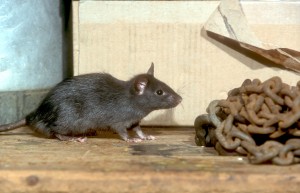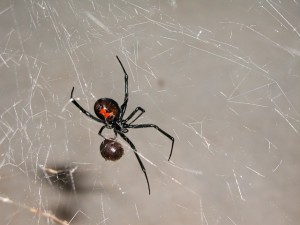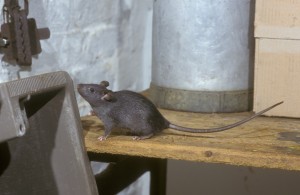With cooler fall weather on its way—we hope!—perhaps with some much needed rain, many of the pests most common and dangerous in our Sacramento region begin to look for warm, snug places to ride out the winter. One of those most likely to move into your home or commercial building is the roof rat, otherwise known as Rattus rattus.

Neither Rattus rattus nor its relative, the Norway rat (Rattus norvegicus) are California natives; both originated in Asia and spread over most of the world centuries ago. The roof rat is smaller than its Norwegian relative, weighing 5 to 10 ounces, and is light gray or near-white in color, with a pointed snout, long ears and a long black tail the length of its body. The Norway rat larger, averaging 7 to 18 ounces, is darker in color, with short ears and tail.
Many of us think of rats as ground-dwelling creatures who scurry along alleys and under the bushes. But Rattus rattus is a climber, and your cozy, insulated attic looks mighty inviting as a place to nest and raise a litter of baby rats. The roofs of many buildings harbor handy entryways for these resourceful, smart and dangerous critters—unscreened ventilation vents, bent or torn flashing around chimneys and pipes, even missing or damaged shingles. Likewise, overhanging tree branches, pergolas and rain gutters offer rats an easy climb to gain access. One local homeowner we know saw a rat scurrying off her roof and over a backyard pergola around twilight one evening, only to lose sight of him in some tree branches. A flashlight revealed the rat’s destination: It was hanging upside down from a tree branch by its back claws, munching on a bird-food bell hung from the same branch.
Signs you have rats can include droppings near pet bowls, food containers or recycling bins; signs of digging near fences or around sheds; the sight of a rat traveling a utility line or tree branch at dusk; or even a rat carcass presented to you by the family pet. But often, particularly in the case of roof rats, you will hear them: scurrying or scuffling sounds, even squeaks or squeals, coming from overhead as you lay in bed late at night.
Disney cartoons aside, Rattus rattus is no laughing matter. Rats eat and contaminate human and animal food and are prodigious chewers fond of electrical wiring. They have been known to chew through phone wires and have been blamed for electrical fires. Roof rats carry many diseases dangerous to humans and pets, including typhus, leptospirosis, trichinosis, salmonella, ratbite fever and plague. Insulation material makes great nesting material, and they often leave it shredded and fouled with urine and feces.
Our pest control company has been assisting homeowners and business owners in eliminating rats for many years. But until recently, there was little we could do to mitigate the structural damage and unsanitary conditions left behind. That’s why we will be rolling out a brand new service, just in time for cool-weather rat season, that will include repair of any structural damage, removal of all contaminated insulation and rat waste, sanitization of the area, and replacement of insulation with a new, environmentally safe blown insulation product that will actually deter rats, insects and other pests from taking up residence in your attic in the future.
Our pest control technicians are already undergoing training in this new product line, and we’ll be telling you more about this new service soon. It is a service our customers have been requesting for some time, and we’re glad to be able to respond—not only in getting the rats out of our customers’ attics, but in returning their homes or commercial spaces to safe, sanitary and healthful conditions.




